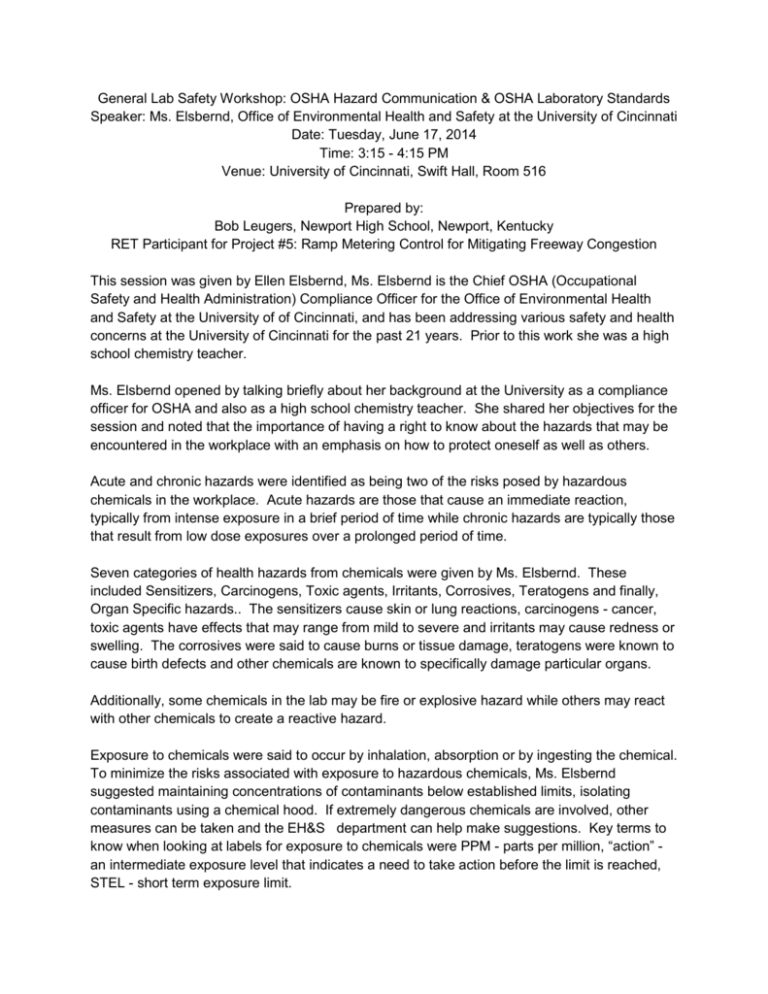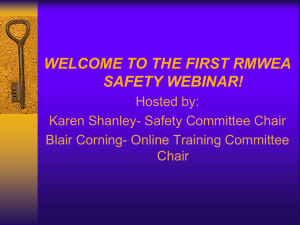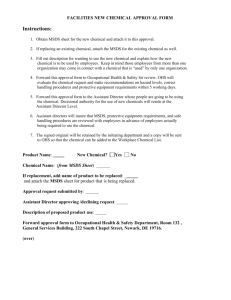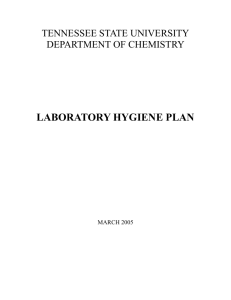Report - University of Cincinnati
advertisement

General Lab Safety Workshop: OSHA Hazard Communication & OSHA Laboratory Standards Speaker: Ms. Elsbernd, Office of Environmental Health and Safety at the University of Cincinnati Date: Tuesday, June 17, 2014 Time: 3:15 - 4:15 PM Venue: University of Cincinnati, Swift Hall, Room 516 Prepared by: Bob Leugers, Newport High School, Newport, Kentucky RET Participant for Project #5: Ramp Metering Control for Mitigating Freeway Congestion This session was given by Ellen Elsbernd, Ms. Elsbernd is the Chief OSHA (Occupational Safety and Health Administration) Compliance Officer for the Office of Environmental Health and Safety at the University of of Cincinnati, and has been addressing various safety and health concerns at the University of Cincinnati for the past 21 years. Prior to this work she was a high school chemistry teacher. Ms. Elsbernd opened by talking briefly about her background at the University as a compliance officer for OSHA and also as a high school chemistry teacher. She shared her objectives for the session and noted that the importance of having a right to know about the hazards that may be encountered in the workplace with an emphasis on how to protect oneself as well as others. Acute and chronic hazards were identified as being two of the risks posed by hazardous chemicals in the workplace. Acute hazards are those that cause an immediate reaction, typically from intense exposure in a brief period of time while chronic hazards are typically those that result from low dose exposures over a prolonged period of time. Seven categories of health hazards from chemicals were given by Ms. Elsbernd. These included Sensitizers, Carcinogens, Toxic agents, Irritants, Corrosives, Teratogens and finally, Organ Specific hazards.. The sensitizers cause skin or lung reactions, carcinogens - cancer, toxic agents have effects that may range from mild to severe and irritants may cause redness or swelling. The corrosives were said to cause burns or tissue damage, teratogens were known to cause birth defects and other chemicals are known to specifically damage particular organs. Additionally, some chemicals in the lab may be fire or explosive hazard while others may react with other chemicals to create a reactive hazard. Exposure to chemicals were said to occur by inhalation, absorption or by ingesting the chemical. To minimize the risks associated with exposure to hazardous chemicals, Ms. Elsbernd suggested maintaining concentrations of contaminants below established limits, isolating contaminants using a chemical hood. If extremely dangerous chemicals are involved, other measures can be taken and the EH&S department can help make suggestions. Key terms to know when looking at labels for exposure to chemicals were PPM - parts per million, “action” an intermediate exposure level that indicates a need to take action before the limit is reached, STEL - short term exposure limit. Identifying and assessing hazards of various chemicals is communicated in part by the Material Safety Data Sheet (or MSDS). The parts of the MSDS include Physical and chemical characteristics, Health & Physical Information, Control Meassures, Emergency First-aid & Spill Procedures, and Protective Exposure Limits. Each person wass told of their responsibility to maintain a chemical inventory for their workspace, having MSDS available and readily available and maintaining exposure records for 30 years after employment has ended. Ms. Elsbernd described the importance of the Hazard Warning Diamond as shown below. *bob*. The top square is associated with flammability, the left, with health, the right, with reactivity and the bottom square associated with specific hazards. Each of these squares contains a number from zero (0) to four (4) with 0 indicating minimal hazard to 4 being extreme. 4 - Extreme 3 - Serious 2 - Moderate 1 - Slight 0 - Minimal The diamond should be placed at the entrance to the lab along with an emergency contact. Engineering controls such as fume hoods can and should be used, according to Ms. Elbernd. In addition, protective gear such as gloves, goggles and lab coats can be used to shield individuals from exposure to hazardous chemicals. Good hygiene and a few safety measures are also a part of the safety process identified by Ms. Elbernd. These include washing hands, avoid eating or bringing food into the lab, securing gas cylinders, storing flammables in proper cabinets, segregating chemicals by hazard class, shielding chemicals from potential fires and inspecting/testing equipment to avoid failures that may result in injury. Precautionary measures were recommended also for nano-particles since most masks cannot filter out particles that small. Instead, particles such as this should be handled in an enclosed process and limit the number of workers handling these materials. Recognizing that accidents will occur, Ms. Elbernd recommended that persons in the lab be familiar with and maintain access to exits, fire extinguishers, eyewash stands, showers, electrical panels and spill kits. Finally, Ms. Elbernd introduced a few of the newer labelling standards that came about as a result of international cooperation at the United Nations to provide a common format making it easier to utilize information contained on these labels. This is an example of the handout provided in this session.






